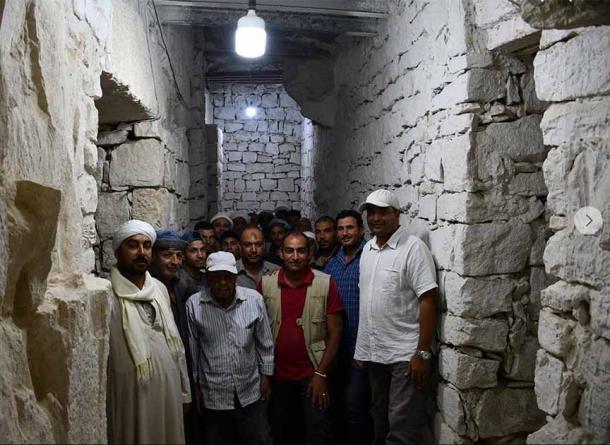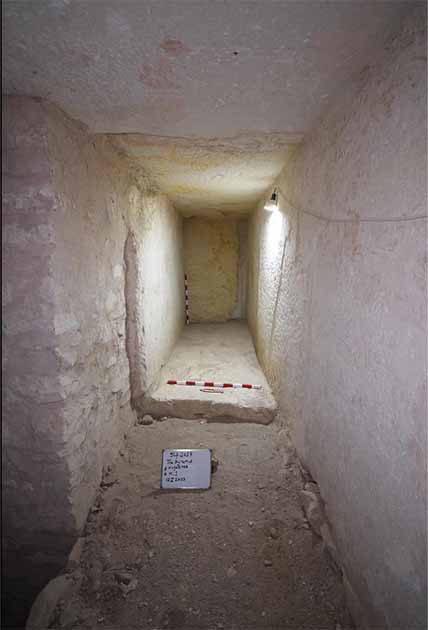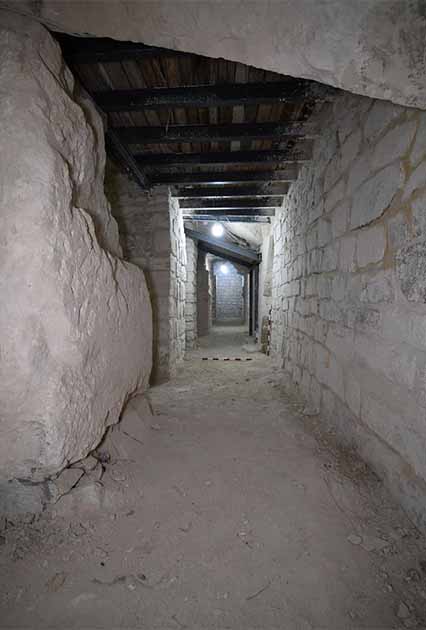
Eight New Chambers Revealed at the Sahure Pyramid
Described as a ‘very significant’ find, eight rooms, that probably accommodated royal grave goods, have been uncovered in the Pyramid of Sahure in Abusir, Giza. These chambers, obscured from the world for over four millennia, have now been brought to light by a dedicated Egyptian-German archaeological team.
The pyramid complex is tied to King Sahure, the second ruler of the fifth dynasty of Egypt, dating back to the 2400 BC. He was also the first ruler to be buried in the Abusir part of the complex.
Though the northern and southern parts of the storage area are severely damaged, remnants of the original walls and parts of the floor can be seen. This Egyptian-German mission has been led by Egyptologist Dr. Mohamed Ismail Khaled of the Department of Egyptology at Julius-Maximilians-Universität of Würzburg (JMU), according to their press announcement.
The conservation and restoration project inside Sahura's pyramid, initiated in 2019 and supported by the Antiquities Endowment Fund (AEF) of the American Research Center in Egypt (ARCE), aimed to safeguard the substructure of Sahura's pyramid. The team's efforts focused on cleaning the interior rooms, stabilizing the pyramid from inside, and preventing further collapse. In the process, the team succeeded in securing the pyramid's burial chambers, which had previously been inaccessible.
Restoration Work: The Sahure Pyramid Standing the Test of Time
During the restoration work, the team discovered the original dimensions and was able to uncover the floor plan of the antechamber, which had deteriorated over time. Consequently, the destroyed walls were replaced with new retaining walls. The eastern wall of the antechamber was badly damaged, and only the northeast corner and about 30 centimeters (12 in) of the eastern wall were still visible.
- The Evidence is Cut in Stone: A Compelling Argument for Lost High Technology in Ancient Egypt
- Archaeologists uncover 4,200-year-old Tombs of ancient Egyptian priests

The joint Egyptian German Archaeological Mission at the Sahure Pyramid. (Egyptian Ministry of Tourism)
Traces of a low passageway that John Perring had already noticed during an excavation in 1836 continued to be excavated. Perring had mentioned that this passage had been full of debris and rubbish and had been impassable due to decay. The British Egyptologist suspected that it might have led to storage rooms, reports Siasat Daily.

One of the 8 storage rooms discovered at the Sahure pyramid in Egypt. (Egyptian Ministry of Tourism)
However, during further exploration of the pyramid by Ludwig Borchardt in 1907, these assumptions were called into question—other experts joined his opinion. All the more surprising was the find of the Egyptian-German team, which actually discovered traces of a passage, thereby proving that the observations made during Perring's exploration were correct.
The work was continued, and the passage was uncovered. Thus, eight storerooms have been discovered so far. Although the northern and southern parts of these chambers, especially the ceiling and the original floor, are badly damaged, remnants of the original walls and parts of the floor can still be seen.

A passageway, now secured with steel beams. (Egyptian Ministry of Tourism)
Using Modern Technology: Ensuring Structural Integrity
Careful documentation of the floor plan and dimensions of each storage room has greatly enhanced the researchers' understanding of the pyramid's interior. During restoration, a balance between preservation and presentation was pursued to ensure the structural integrity of the rooms while making them accessible for future study and potentially the public.
Using state-of-the-art technology, including 3D laser scanning with a ZEB Horizon portable LiDAR scanner from GeoSLAM, the Egyptian-German team collaborated with the 3D Geoscan team to conduct detailed surveys inside the pyramid.
This advanced technology enabled comprehensive mapping of both the extensive external areas and the narrow corridors and chambers inside. The frequent scans provide real-time updates of progress and create a permanent record of exploration efforts.
- Two 26th dynasty tombs unearthed in Egypt containing mummies and fascinating grave goods
- Archaeologists find 4,000 year-old tomb of prominent doctor to pharaohs southwest of Cairo
King Sahure: Indelible Mark on Egyptian Architecture
King Sahure ruled Egypt around 2490-2475 BC and is remembered as a ruler who left a significant mark on Egyptian architecture and culture during the Old Kingdom period. His pyramid complex at Abusir is a testament to his innovative approach to pyramid construction. Abusir is a necropolis near present-day Cairo, with the pyramid complex including a valley temple and a causeway.
Interestingly, the Pyramid of Sahure, is relatively smaller than those of some of his predecessors but marks a transition in pyramid design, featuring innovative elements such as the use of finer Tura limestone casing. The original design measured 47 meters (154 ft) in height and had a base measuring approximately 78 meters (256 ft) on each side. The complex included a mortuary temple, a causeway leading to the valley temple, and a subsidiary pyramid for a queen.
Top image: View of the Sahure pyramid from the outside at Abusir, Egypt. Right; Dr. Mohamed Khaled, project leader, during the excavations in the Sahure pyramid. Source: Mohamed Khaled / Uni Würzburg, Sailingstone Travel/Adobe Stock
By Sahir Pandey
References
Wurzburg University. 2023. New rooms discovered in Sahura's pyramid. Available at: https://phys.org/news/2023-09-rooms-sahura-pyramid.html.
Xinhua. 2023. Egypt uncovers 8 storage rooms in Pyramid of Sahure. Available at: https://www.standardmedia.co.ke/africa/article/2001482338/egypt-uncovers-8-storage-rooms-in-pyramid-of-sahure.















